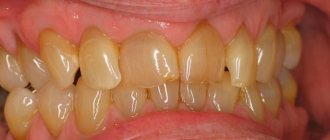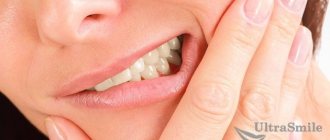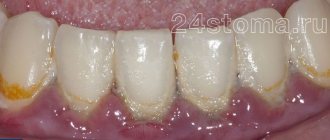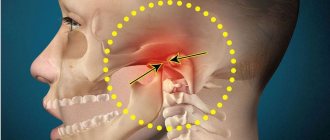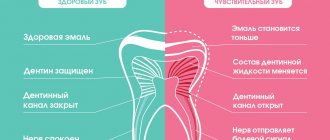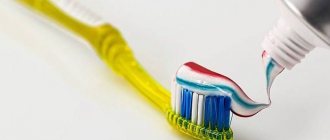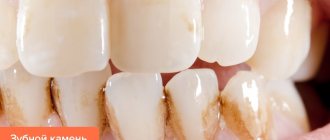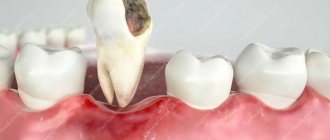17.11.2019
Acute toothache can take you by surprise. To get rid of it forever, you need to see a dentist, but first you can relieve toothache with the help of folk remedies that have a quick pain-relieving effect. To choose the right remedy for self-relief of pain, you should be guided by common sense, knowledge about the causes of pain and the properties of the substances used in therapy.
Modern dental treatment
Dental treatment of teeth is a set of measures aimed at eliminating the inflammatory process and restoring chewing functions. The most common disease is, of course, caries and its complications. The timing of dental treatment directly depends on the stage of development of the disease. Thus, installing a dental crown or implanting several teeth will take different times, depending on the number of specialist appointments. It is worth noting that regular preventive examinations allow you to notice pathologies at an early stage, allowing for dental treatment without extraction and significantly simplifying it.
If a patient comes to the clinic with acute pain, the task becomes much more complicated. Therefore, every dentist will tell you that the best dental treatment is prevention.
Photos before and after dental treatment
Photos Before and After treatment of chewing teeth.
Photos Before and After treatment of front teeth.
What methods do dentists use to combat caries?
All methods of treating dental caries can be divided into two large groups - invasive and non-invasive. The first involves treating enamel caries without preparation. This option is most often used when the carious lesion is in its initial stage, there is no extensive damage to the deep tissues of the tooth, or there are indications for anesthesia.
Invasive technologies are used much more often and involve tooth preparation and removal of tissue affected by caries. The degree of preparation depends on how severely and deeply the tooth is affected.
The optimal treatment regimen and method is always selected by the dentist, taking into account age, individual characteristics, stage of disease development, anesthesia tolerance and other factors.
Endodontic dental treatment
What is endodontic dental treatment? This is a procedure aimed at treating root canals, usually using a microscope. If you ignore the symptoms of caries for a long time, pulpitis, periodontitis and other complications develop. Endodontic treatment of teeth under a microscope will help eliminate acute pain and relieve inflammation. The help of an endodontist is indispensable when there is a suspicion of a dental cyst or granuloma. Often, after canal treatment, complications arise due to poor quality treatment or stuck pieces of broken instruments. In such difficult cases, they also resort to endodontic treatment of the tooth canal under a microscope.
Treatment without drilling
Dental treatment without drilling involves the use of minimally invasive procedures. Some of them have been mentioned above. In particular, lasers are actively used to eliminate caries. This type of dental treatment is performed for adults and children. Among the main advantages is a reduced risk of any infection, since contact of equipment with organs and tissues of the oral cavity is eliminated.
Also, dental treatment without a drill can be performed using the chemical-mechanical method. A special preparation is applied to the area of the tooth affected by caries. It contains sodium hypochlorite and amino acids. Next, the specialist treats the affected area using special tools. Since only dead tissue is removed, the filling occupies a much smaller area, and it is also possible to preserve healthy areas as much as possible.
Another interesting technique was developed by German specialists. It is based on the bactericidal properties of ozone and is often used in pediatric dentistry. The gas used to treat teeth completely destroys microorganisms that cause caries.
The latest non-invasive methods
Before dental treatment, a specialist determines the degree of destruction of enamel, hard tooth tissue and dentin. In advanced cases, a granuloma forms around the root, which may subsequently increase in size. Modern methods of dental treatment make it possible to successfully combat the first signs of caries without the use of a drill. Among them:
- laser dental treatment;
- application of chemical-mechanical techniques;
- fluoridation – treatment of teeth with calcium;
- application of the air-kinetic method;
- ozone therapy.
Mechanical and chemical-mechanical preparation
With the mechanical method, the carious cavity is prepared using hand instruments and dental burs. This option is the most common.
During chemical-mechanical preparation, the dentist first acts on the affected dental tissues with special solutions and gels that destroy the areas affected by caries. And then, using hand instruments, he cleans the cavity and fills it.
There is also an ART technique developed in Russia, in which the affected tissue is first removed with a hand instrument, then gels with different effects are applied one by one. The treatment is completed by re-cleaning the cavity using instruments and rinsing with water.
Treatment of a tooth under a crown
After some time has passed after the installation of the prosthesis, subsidence of the gums and exposure of the neck of the tooth are often observed. All this contributes to the development of caries, and therefore pulpitis, periodontitis and other unpleasant diseases can appear even when the tooth is covered with a crown. Only a specialist can identify the problem and treat the tooth under the crown. If a disease is detected, the structure may need to be removed.
It is also the cause of problems - errors in the manufacture of the prosthesis: if the crown does not fit tightly around the neck of the tooth, bacteria can get under it. The specialist immediately removes such structures and carries out dental treatment. The crowns will subsequently be replaced, which will preserve the teeth and prevent the development of more serious diseases.
Initial oral health assessment
As doctors note, every patient who decides to restore lost teeth needs preparatory procedures. You cannot come to your first consultation with an orthopedist and immediately begin installing prostheses. A competent specialist must draw up and propose a preliminary treatment plan, and there may be several options. The basis will be an initial visual examination and radiographic data. The plan is drawn up taking into account further procedures: removal or treatment of diseased elements, preparation of supports for installation of the structure, etc.
Don't know what type of prosthetics to choose?
We will help in the selection, advise where to read more information and compare types of prosthetics.
Consultation with an orthopedic doctor in Moscow clinics is free! Call now or request a call
Working hours: from 9:00 to 21:00 - seven days a week
All this will affect the long-term results of recovery: the more complete the picture is compiled during the examination, the more detailed the algorithm of preparatory measures will be developed. At the same time, the cost of prosthetics is assessed, the treatment period is calculated, and the patient is determined with the type of prosthesis suitable for his situation and capabilities.
Deciding on the choice of design is also not very easy. Today there are various types of prostheses, crowns, bridges and their fastenings. Taking into account individual characteristics and the clinical situation, the doctor will advise the best options. But there are also pitfalls that it is better to know about in advance. Therefore, it is better to ask the doctor “on the shore” about the pros and cons of the chosen prosthetic method.
What modern types of prosthetics exist, and which are already a thing of the past, read the article on the website “Is dental prosthetics becoming obsolete”?
Anesthesia
Conventional local anesthesia is performed very often today. Patients with increased sensitivity of soft tissues and children can first be given topical anesthesia. Also in dentistry, painkillers are used for dental treatment. The type of drug and its dosage are selected individually - it all depends on both the patient’s health condition and the clinical situation. For example, pediatric dentists often treat teeth with nitrogen. Laughing gas causes a feeling of mild euphoria and is not hazardous to health. The patient relaxes, and the doctor can calmly perform all the necessary manipulations. But general anesthesia in dentistry is used only in the most extreme cases.
Anesthesia after dental treatment can last up to 3 – 4 hours. Everything here is very individual and depends on how much anesthetic was used.
Universal folk recipes against toothache
Regardless of the cause of pain, the main task when eliminating it at home is not to provoke inflammation and not to harm the diseased tooth. Therefore, it is permissible to use only gentle natural analgesics. The fastest and most effective folk remedies for toothache are:
- Rinse with saline solution with iodine. A teaspoon of sea or table salt and 7 drops of iodine are dissolved in a glass of warm boiled water. The solution can be used immediately after the crystals of the substance have completely dissolved. The intensity of pain decreases after 3–5 minutes. It is permissible to rinse your mouth no more than three times a day.
- Rinse with green tea and garlic. A tablespoon of green tea is brewed in 250 ml of boiling water. The drink is infused for 15 minutes, after which you need to add 5 cloves of garlic, grated on a fine grater. The mixture should be left for another ten minutes and then strained. Immediately before use, the tea should be warmed to a comfortable room temperature.
Gargling is not the only way to get rid of toothache at home using garlic. You can simply grate a vegetable clove and apply the resulting pulp to the inflamed gum; the essential oils it contains will help eliminate pain and have an antiseptic effect.
- Lotion with valerian. A cotton pad is cut into 4 parts, one piece is soaked in an alcoholic infusion of valerian and placed on the sore tooth. As necessary, the tampon is replaced with a new one.
- Compress with salt, onion and garlic. To prepare an anesthetic paste, you need to finely grate the onion and garlic cloves and mix the resulting paste with salt. Take a teaspoon of all ingredients. The paste is applied to the diseased tooth and covered with a cotton swab. The compress eliminates pain within a few minutes. This method of pain relief can be used an unlimited number of times a day.
Mouth rinse with herbal infusions
Warm decoctions for rinsing are effective for toothache of any nature. The simplest folk remedy that helps quickly eliminate toothache is rinsing with soda and salt: half a teaspoon of soda and three drops of iodine are diluted in a glass of warm boiled water. The solution numbs the tooth and disinfects the oral cavity.
To prepare 250 ml of herbal decoction, use 1 tablespoon of dried medicinal plants. The raw material is poured with a glass of boiling water and boiled in a water bath for 10 minutes, after which it is filtered. You can use the product after it has cooled.
The most effective are decoctions based on:
- sage;
- mint;
- oak bark;
- echinacea;
- chamomile flowers;
- eucalyptus.
The beneficial analgesic effect of herbal rinses is recognized even by dentists, but when using them you must adhere to precautions:
- The decoction for rinsing inflamed gums and sore teeth should be warm; too hot or cold liquid can provoke increased inflammation.
- Medicinal herbs can cause severe allergic reactions in the form of rashes and swelling of the oral cavity, which can spread to the larynx, bronchi and even lungs. Therefore, for the initial use of each herbal collection, no more than 50 g of decoction should be used.
Lotions with essential oils
Essential oils have an anesthetic effect on the nerve, causing it to become temporarily numb. The most effective painkillers are oils:
- lemon balm;
- carnations;
- lemon;
- geraniums;
- basilica;
- cajuput tree;
- eucalyptus;
- fir trees
Method of use: two or three drops of essential oil are applied to a cotton swab, which is applied to the aching tooth for 5–7 minutes.
Essential oils are very concentrated, so it is forbidden to drip more than four drops and exceed the time of keeping the compress: there is a high risk of burning the mucous membrane and causing a sharp headache. The procedure can be repeated no more often than every 2 hours.
Features of treatment of anterior teeth
Treatment of anterior teeth is associated with some difficulties. A characteristic feature of the incisors is their smaller size compared to other teeth. The work that a dentist has to do is truly jewelry. Only an experienced specialist can achieve a high degree of aesthetics.
In the process of treating and restoring the shape of a diseased tooth, a filling can be performed using light-curing polymer materials or veneers. Their shade is selected taking into account the color of the enamel of the patient’s healthy teeth.
The last resort is the installation of crowns. This method is justified only if the tooth is severely damaged. Treatment of lower teeth in the frontal zone is performed using similar methods and techniques.
Application of computer technology
Periodontitis diagnostic system “FLORIDA PROBE” (USA)
Today, diagnosis, treatment, and dental prosthetics are unthinkable without the use of one form or another of computer technology. Special computer programs are capable of simulating the patient’s oral cavity, which allows the doctor to more effectively make a diagnosis, select the type of therapy and prosthetics, and prescribe recommendations for the patient. And the patient gets the opportunity to visually familiarize himself with the condition of his teeth and better understand what their treatment and prosthetics will consist of.
Intraoral video camera
One of the most recent achievements is the so-called neuromuscular dentistry, which studies the neurophysiology of the oral cavity and the characteristics of the patient’s jaw movement and the activity of the masticatory muscles. It is quite obvious that obtaining and processing this kind of data is impossible without sophisticated computer technology. Also, in the country's leading clinics, programs are used that study the patient's facial expressions. Together, this allows the dentist to use a full animated model of the oral cavity, displayed on a computer display, where he can rotate the three-dimensional image in any direction and view it from different angles.
The intraoral camera is another new product that significantly facilitates the doctor’s work. The device is a microscopic video camera that is placed in the patient’s mouth and transmits an enlarged image to a computer screen. As a result, both the doctor and the patient have the opportunity to examine the condition of the teeth and gums in great detail. Sometimes, with the help of such a camera, a doctor can see details that even an x-ray cannot show him.
Reason to see a doctor: symptoms that cannot be ignored
If a tooth hurts, treatment should never be delayed. Any delay is fraught with serious problems not only for the oral cavity, but also for the whole body. The sooner the source of infection is identified, the easier and faster dental treatment can be performed in the clinic. Symptoms that indicate serious problems:
- acute throbbing pain in the tooth;
- significant increase in sensitivity;
- bad breath during regular hygiene;
- bleeding and swelling of the gums;
- tooth mobility;
- difficulty opening the mouth;
- the appearance of a defect on a tooth, an area with uneven edges and pigmentation.
Stages of dental treatment
Despite the fact that modern methods involve virtually painless dental treatment, fillings and other procedures, many patients appear in the doctor’s office with acute pain and a whole “bouquet” of oral diseases. Treatment usually includes the following steps:
Diagnostics
A specialist examines the oral cavity, identifies problems and draws up a treatment plan. Additional examinations may be ordered. At the same stage, the doctor conducting the consultation discusses the cost of services with the patient and selects the most convenient time for an appointment.
Professional oral hygiene
It is advisable to begin dental treatment only after their surface is cleaned of hard and soft deposits.
Treatment
The process of treating caries involves removing the affected tissue. The procedure is performed using local anesthesia, and the treated area is isolated from the rest of the mouth. Rubber dam or cotton swabs can be used for these purposes.
Seals
Filling is carried out after cleaning the carious cavity. The final procedure is grinding the filling - this is necessary to eliminate the occurrence of discomfort during the process of chewing food.
Air-abrasive method of preparation
Essentially, this is sandblasting the hard tissues of a diseased tooth. Through a special tip, an aerosol containing water and an abrasive substance is applied to the surface of the tooth. This method is used before sealing fissures or to remove pigmented areas of tooth enamel.
The air abrasive method can be used to prepare small carious cavities. The advantages of this method are minimal tissue excision and the creation of a rough surface that does not require additional acid etching.
Why does a tooth hurt after treatment and what to do in this case?
Aching pain after treatment occurs quite often. However, its causes may be different, which means that the doctor’s actions to eliminate it are required different. Let's look at the most popular:
- Very often, after treatment, the tooth reacts to mechanical stress when chewing food. As a rule, minor pain appears after treatment of deep caries. This is due to the fact that the filling puts pressure on the pulp. Over time, the pain will pass.
- It is not uncommon for a tooth to ache after treatment and due to an individual reaction to the doctor’s intervention. The pain may persist for several days.
- Acute pain after dental treatment cannot be ignored. You must immediately contact a specialist. Unpleasant pain may indicate that there is inflammation after dental treatment.
- If you are sensitive to irritants such as hot and cold drinks, sweet or sour foods, then there is a high probability that the overhanging edge of the filling will injure the periodontal tissue in the gum area. This phenomenon leads to tissue inflammation and exposure of the tooth root, which is extremely sensitive to any irritants. Therefore, be sure to contact the dental clinic if your tooth aches after recent manipulations. The treatment was most likely carried out poorly.
How much does dental treatment cost in Moscow?
Taking into account the fact that therapy involves an integrated approach, the total cost of dental services will consist of the costs of individual procedures. Approximate prices for dental treatment in Moscow are presented in the table below.
| Type of service | Price |
| Specialist consultation | from 500 rubles, but most often it is free |
| Professional hygiene of the entire oral cavity | from 3,000 rubles |
| Treatment of pulpitis (depending on the number of channels) | from 4,000 rubles |
| Filling using light-curing polymer material | from 3,000 rubles |
| Aesthetic restoration of anterior teeth | from 5,000 rubles |
